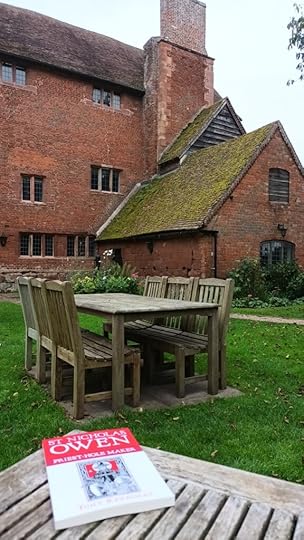Book Review: ‘St Nicholas Owen: Priest-Hole Maker’ by Tony Reynolds
This past weekend I visited Harvington Hall in Worcestershire – a 14th century house built upon an island and surrounded by a moat both of which can be traced back to the 13th century. A recusant Catholic family lived here so it was a focus for Jesuit priests who had come to Britain during the dangerous period of Catholic persecution in the reign of Elizabeth I. Their mission was to turn England back to Catholicism again.
 Book cover image of St Nicholas Owen by Tony Reynolds
Book cover image of St Nicholas Owen by Tony ReynoldsHarvington Hall is known as the House of Secrets as it has an incredibly complicated structure, designed to confuse visitors, and contains a total of seven ingenious priest-hides, many of which are known to have been constructed by Nicholas Owen, master priest-hole builder. Nicholas Owen is the patron saint of illusionists and escapologists, too!
 Harvington Hall (photo credit Sheila Robinson)
Harvington Hall (photo credit Sheila Robinson)In the shop at Harvington Hall I bought this book ‘St Nicholas Owen: Master Priest-Hole Maker‘ and finished reading it last night. It is a rivetting account of an enormously brave, loyal and gifted carpenter, stonemason and joiner, whose priest-holes in various Catholic houses were so cunning and clever, that there are probably still some around the country that are yet to be discovered. Baddesley Clinton Manor is one of the houses that benefited from Nicholas’s skill and loyalty. Baddesley Clinton is one of my favourite National Trust properties along with Coughton Court, and very near to where I live in Warwick; I’ve visited it many times.
 Cafe tables and chairs in the back garden of Harvington Hall with copy of book St Nicholas Owen by Tony Reynolds (photo credit Sheila Robinson)
Cafe tables and chairs in the back garden of Harvington Hall with copy of book St Nicholas Owen by Tony Reynolds (photo credit Sheila Robinson)So I thought it was about time I read about the life of this fascinating and enigmatic man, Nicholas Owen, who was probably about five feet tall and was nevertheless amazingly strong, for he constructed most of the priest-holes unaided and by hand. He would excavate into thick walls; re-site staircases; change floor levels; create secret entrances from a swinging hinged floorboard or flagstone, and numerous other devices to burrow out a secret hide, where the priests could keep out of sight while pursuivants (priest-hunters) rampaged through the house tearing down panelling etc. I hadn’t previously realised that they also charged (or fined) the householder afterwards for the cost of their time and trouble wrecking the house!
 Harvington Hall and moat (photo credit Sheila Robinson)
Harvington Hall and moat (photo credit Sheila Robinson)Ultimately Nicholas suffered for his hard work, dedication and prolific career; he was arrested and then tortured to death in the Tower of London, never giving away any of the names of the people he had associated with, whether Jesuit priests, or those responsible for hiding them. Later, the Catholic Church made him a saint.
 View of Harvington Hall and front garden (photo credit Sheila Robinson)
View of Harvington Hall and front garden (photo credit Sheila Robinson)This story tells all that is known about Nicholas, and it is riveting, emotional, moving and horrific. It is also a meticulous account, giving us a good background into the persecution and its historical significance. Ultimately the reader cannot but be awed by his courage and singlemindedness: and the same goes for the priests and those who shielded them. The Vaux sisters, Anne and Eleanor, stand out in this story too; and also the priests, Edmund Campion, Henry Garnet, Robert Southwell and John Gerard.
I have read of these priests before in the excellent book God’s Secret Agents by Alice Hogge – another book I can highly recommend.
 Book cover image God’s Secret Agents by Alice Hogge
Book cover image God’s Secret Agents by Alice HoggeJohn Gerard effected an astonishing escape from imprisonment in the Tower of London – and remained in the country for several years afterwards, continuing his work in extreme danger, until he was recalled to the English college seminary in Rome again. Later he was asked to write a full account of his life; and to his dramatic account we are indebted for much of what we know about this period. It reads like a thriller, and readers cannot but have huge admiration for him.
 Harvington Hall Moat (photo credit Sheila Robinson)
Harvington Hall Moat (photo credit Sheila Robinson)His fellow-priests were not so lucky, meeting the hideous death meted out to those designated ‘traitors’: hanging, drawing and quartering. It is heart-breaking to realise that Henry Garnet was condemned to execution along with several Gunpowder Plotters because one of them had confessed his plan, and Garnet had honoured the confidentiality of confession, and failed to reveal it to the authorities. So he went the way of the rest of them – even though he had strongly opposed the Plot, and advised the plotters against it. It is now even thought that the Plot was carried out by agents provocateurs – for it served to ruin the Catholic Cause in England – something any of them with insight must have foreseen (although of course we are always wise in hindsight!!)
As for Nicholas, even after he had been tortured to death, the final insult was that his torturers manufactured a story that he had committed suicide, to save themselves from getting into trouble. However, the truth will out, and now we know about the life and work of this remarkable man.
Read the book, and visit Harvington Hall, and some of the other historical houses which carry such rich stories in their very fabric.


Why not join me on my writing journey and sign up to receive my monthly newsletter straight to your inbox. I share gems and snippets from my research discoveries, and news and insights from the writing and publishing worlds, plus you’ll be the first to see new cover reveals and to know when I have a new book coming out.
If you’d like to support me through buy me a coffee I’d be very grateful!



